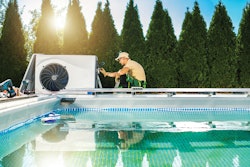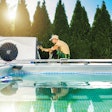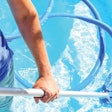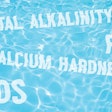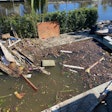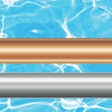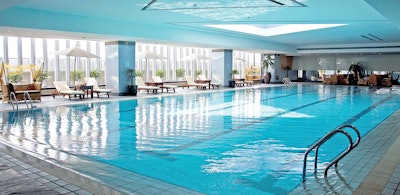
Indoor swimming pools offer challenges both in maintaining proper water balance and proper sanitization. Volatilization of chlorinated and/or brominated disinfection by-products combined with decreased fresh air exchange can create conditions that may be less than ideal for swimmers and operators in these venues.
This article explores these disinfection by-products (DBP), potential risks associated with them and current practices to help mitigate these potential risks. It is generally accepted that the benefits associated with swimming outweigh any potential risks in indoor venues; however, the positive benefits of swimming should be enhanced by minimizing exposure to DBP.
ENCLOSED AQUATICS
Indoor recreational water facilities grew from the desire of people in colder climates to continue swimming during the winter months. Since these indoor swimming pools are specifically designed to limit exposure to the outside environment, they have always faced challenges with balancing water chemistry, maintaining heat and humidity levels in the facility as well as providing fresh air exchange around the pool. Since there is no natural wind in the facility, the indoor air can stagnate without proper ventilation. With typically warmer air in an indoor facility, humidity control can also be a challenge as water evaporates from the pool.
Disinfection in swimming pools, whether indoors or outdoors, requires the use of a primary sanitizer, in many cases chlorine. When chlorine reacts with organic waste materials left behind by bathers, chlorinated by-products can form. These by-products can be volatile and escape from the water into the surrounding air. Being heavier than air, many of these by-products can hover around the surface of the pool and on the pool deck. In outdoor pools, air movement generally disperses many of these byproducts, however in indoor facilities, that air movement can be limited thus allowing for greater concentrations to accumulate.
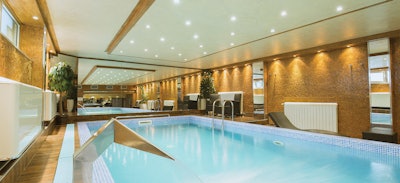 Disinfection in swimming pools, whether indoors or outdoors, requires the use of a primary sanitizer, in many cases chlorine. When chlorine reacts with organic waste materials left behind by bathers, chlorinated by-products can form.
Disinfection in swimming pools, whether indoors or outdoors, requires the use of a primary sanitizer, in many cases chlorine. When chlorine reacts with organic waste materials left behind by bathers, chlorinated by-products can form.DISINFECTION BY-PRODUCTS (DBPS) AND PRECURSOR CHEMICALS
Swimmers leave behind a myriad of organics and other chemicals in the water that can react with chlorine to form DBPs. These include such things as urea and creatinine (from sweat and urine), oils and other organics (from personal care products), and other nitrogen-containing compounds. DBPs can take the form of inorganic or organic chloramines. Inorganic forms are primarily trichloramine (NCl3), dichloramine (NHCl2) and monochloramine (NH2Cl). Another class of DBPs is typically referred to as trihalomethanes (THMs) of which chloroform (CHCl3) is a primary concern. A study in Barcelona, Spain (Richardson 2010) identified over 100 DBPs, many of which had not been previously identified in the literature. This is an area open to further research.
DBPS IN INDOOR SWIMMING POOLS
Several studies have looked for a correlation between the concentration of DBPs in indoor swimming pool water and the concentration of DBPs in indoor air around these pools. At least one study did find significant concentrations of DBPs in both the pool water and the surrounding air, but the correlations between the air concentration and the pool concentration was not strong. However, another study found several factors do correlate the air concentration with the pool water concentration of DBPs. First, is the time of day. Later in the day, more use of the pool and agitation of the water resulted in higher air concentrations of the DBPs. Second, an increase in the number of water changes was associated with a decrease in the air concentration of DBPs. Third, increased ventilation (air changes per hour) resulted in a decrease in DBPs in the air. These studies have identified a wide variety of DBPs in the air surrounding indoor pools. They also indicate the difficulties correlating the concentration of DBPs in indoor pool water to indoor air quality. There is still a lot to learn and further studies are needed.
 Swimmers leave behind a myriad of organics and other chemicals in the water that can react with chlorine to form DBPs. Simply showering before entering the pool and reducing the amount of personal care products while swimming can greatly cut down the amount of chemicals that can react with chlorine and lead to DBPs.
Swimmers leave behind a myriad of organics and other chemicals in the water that can react with chlorine to form DBPs. Simply showering before entering the pool and reducing the amount of personal care products while swimming can greatly cut down the amount of chemicals that can react with chlorine and lead to DBPs.HEALTH CONCERNS
Users of indoor swimming venues can sometimes detect a very strong odor of chlorine in the air when they are on the pool deck. This is a sign that there may be chloramines and/or disinfection by-products building up in the air and/ or pool water. It is not a sign of too much free chlorine in the water, it is most likely a sign that there is not enough free chlorine in the water. Chloramines have often been implicated in cases of eye and breathing irritation. In fact, the odor and eye irritation is often the first indication that the water balance and/or ventilation around the pool needs to be corrected.
Beyond the acute eye and respiratory symptoms, exposure to chloramines and other DBPs has been investigated for potential long-term effects to human health. In laboratory studies, exposure to certain DBPs have been associated with respiratory irritation, developmental toxicity and cancer; however, exposure duration and air concentrations are key factors and association of these effects with swimming pool use continues to be investigated. There have been several studies that examined use of indoor pools and rates of asthma in children, competitive swimmers as well as pool workers. A 2012 published review paper assessed the available epidemiological data and concluded that “the body of evidence indicates that asthma in children is not increased by swimming pool attendance” It was also reported that there is a higher “prevalence of respiratory symptoms including asthma… among swimming pool workers and elite swimmers, although the causality of this association is not clear.” Additionally, in summarizing the available data, Villanueva (2012) reported that evidence supports that the use of swimming pools during pregnancy is not associated with increased risk of adverse reproductive outcomes.
Several additional studies (Villanueva 2015, Kogevinas 2010, Pandics 2018) have continued to investigate the relationships between DBPs exposure and chronic illnesses (including cancer). While there has been continued research in this area, further research is still needed to further elucidate the actual risks based on exposures to DBPs in indoor swimming pools. Therefore, it is prudent to limit exposures to DBPs as much as feasibly possible.
 One study has found significant concentrations of DBPs in both the pool water and the surrounding air, but the correlation between the air concentration and the pool concentration was not strong.
One study has found significant concentrations of DBPs in both the pool water and the surrounding air, but the correlation between the air concentration and the pool concentration was not strong.WAYS TO IMPROVE INDOOR AIR QUALITY AT SWIMMING VENUES
One way to reduce DBPs in swimming pools is to reduce the amounts of the precursor chemicals that are introduced into the pool. Reducing swimmer waste is the first step in improving air quality. Simply showering before entering the pool, reducing the use of the pool as a bathroom, and reducing the amount of personal care products while swimming can greatly cut down the amount of chemicals that can react with chlorine and lead to DBPs. Water replacement is another means of reducing both DBPs and DBP precursors.
Proper water balance should be always followed and in all areas of the pool. Follow PHTA ANSI Standard-11 for water balance parameters. A paper on pH and its effect on DBP formation (Hansen 2012) found that THM formation was reduced at pH less than 6, however NCl3 was an order of magnitude higher than at pH 7.5. Hansen published a subsequent paper in 2013 that showed that the effect of pH on genotoxicity of the DBPs at 6.8 to 7.5 was negligible but greatly increased below that. Maintaining PHTA water balance standards is required.
Appropriate ventilation is important to minimize the accumulation of DBPs around the surface of the pool and pool deck. PHTA ANSI-11 Standard advises to follow ASHRAE Standard 62.1-2004 for management of indoor air quality. Per Standard 62-2004, outdoor air should be supplied with a velocity of 0.48 CFM per square foot of pool and wet deck area. They further advise that for natatoriums there should be 4 to 6 air exchanges per hour and 6 to 8 in the spectator area. ASHRAE also recommends directing a portion of the supply air across the surface of the pool to direct chloramines away from the pool. Relative humidity should also be controlled at 40 to 60%. Keeping the natatorium slightly negatively pressured (10 to 15%) is also recommended to improve the air quality.
Minimizing the amount of chlorine used can also limit the amount of DBP formation. While 1 to 4 ppm still must be maintained at all times, monitoring these levels and ensuring that too much chlorine is not used can cut back on DBP formation. Limiting times when shocking the pool to allow for air circulation to remove any excessive DBPs from the air can help reduce those chemicals when swimmers are present.
Technology may also contribute to improvements in air quality by reducing DBPs before they leave the pool water; however, the results from these technologies are mixed. A lab study in 2016 found that ozone can actually increase THM formation upon initial use, however repeated use can decrease total organic matter and THM formation. The study did find that other DBPs could increase with the use of ozone in the lab and does recognize the need for a study in an actual pool. In a study by Li and Blatchley (2008), the ultraviolet (UV) photolysis of monochloramine (NH2Cl), dichloramine (NHCl2), and trichloramine (NCl3) in aqueous solution was investigated at wavelengths of 222, 254, and 282 nm. All three chloramines can be degraded by UV irradiation, and the quantum yields for these processes are wavelength-dependent. On the basis of the results, a mechanism of photodecay of monochloramine is proposed. In a subsequent study Weng and Blatchley (2012) found that UV caused a decrease in inorganic chloramines, but in the presence of a free chlorine residual, UV caused an increase in organic chloramines such as dichloromethylamine (CH3NCl2), dichloroacetonitrile (CNCHCl2) and cyanogen chloride (CNCl). They also found that UV increased the free chlorine consumption rate.
REFERENCES
- Richardson, Susan B. et al., What’s in the Pool? A Comprehensive Identification of Disinfection By-products and Assessment of Mutagenicity of Chlorinated and Brominated Swimming Pool Water. Environmental Health Perspectives 118:11, 2010.
- Li, Jing and Blatchley III, Ernest R. Formation of Volatile Disinfection By-Products from Chlorination of Organic-N Precursors in Recreational Water. Environ. Sci. Tech. 41:6732- 6739. 2007.
- Kanan, A.A., Occurrence and Formation of Disinfection By-Products in Indoor Swimming Pool Water, Clemson University, Graduate Dissertation, July 2018.
- Levesque, Benoit. Et al., Investigation of Air Quality Problems in an Indoor Swimming Pool: A Case Study. Amm. Occup. Hyg. Vol. 59, No. 8 1085-1089. 2015.
- Villanueva, C. and Font-Ribera, L. Health Impact of Disinfection by-products in swimming pools. Ann Ist Super Sanita Vol 48. No.4 387- 396. 2012.
- Bernard A. et al. Lung Hyperpermeability and Asthma Prevalence in Schoolchildren: Unexpected Associations with the Attendance at Indoor Chlorinated Swimming Pools. Occup Environ Med: 60:385-394. 2003.
- Bowen, Anna B. et al. Outbreaks of ShortIncubation Ocular and Respiratory Illness Following Exposure to Indoor Swimming Pools. Environmental Health Perspectives. Nov. 28, 2006.
- Nemery, B. et al. Indoor Swimming Pools, Water Chlorination and Respiratory Health. Eur. Respir .J. 19: 790-793. 2002.
- Hansen, Kamilla. Et al. Effect of Ozonation of Swimming Pool Water on Formation of Volatile Disinfection By-Products – A Laboratory Study. Chemical Engineering Journal. 289:277-285. 2016.
- Lakind, Judy S. et al. The Good, the Bad, and the Volatile: Can We Have Both Healthy Pools and Healthy People? Environmental Science and Technology. 44:3205-3210. 2010.
- Hansen, Kamilla. Et al. Optimal pH in Chlorinated Swimming Pools – Balancing Formation of By-Products. J. Water Health. 11(3):465-472. 2013.
- Hansen, Kamilla. Et al. Effect of pH on the Formation of Disinfection By-Products in Swimming Pool Water—is Less THM Better? Water Research. 46(19):6399-6409. 2012.
- Villanueva, Cristina M. Cordier, Sylvaine. Overview of Disinfection By-Products and Associated Health Effects. Curr Envir Health Rpt. 2:107-115. 2015.
- ANSI/APSP/ICC-11 2019 American National Standard for Water Quality in Public Pools and Spas by the Pool and Hot Tub Alliance, 2019. www.phta.org
- ANSI/ASHRAE Standard 62.1-2016
- Li, Jing and Blatchley III, Ernest R. UV Photodegradation of Inorganic Chloramines, Environ. Sci. Technol. American Chemical Society, 2009, 43, 1, 60–65. Publication Date: November 26, 2008. https://doi.org/10.1021/ es8016304
THE PHTA RECREATIONAL WATER QUALITY COMMITTEE
Jody O’Grady, Taylor Technologies, Inc., Chair
Terry Arko, HASA, Inc.
Kevin Cox, NSF International
Dr. James Egan, LaMotte Company
Philip Escobedo, Fluidra
Rich Gallo, Pure Swim, Inc.
Kenneth Gregory, Pentair Water Quality Systems
Dr. Christopher M. Kareis, Axiall, A Westlake Company
Dr. Joseph Laurino, Periodic Products, PHTA Board of Directors Liaison
Touraj Rowhani, Sigura
Terry Snow, TLS Pool Service / Independent Pool and Spa Service
Association (IPSSA) Representative
Dr. Roy Vore, Vore & Associates LLC
John Weber, BioLab, Inc.
Voting Alternates:
Jeff Gaulding, BioLab, Inc.
Ellen Meyer, Sigura
Consultants:
Jana Auringer, Pebble Technology International
Beth Hamil, MicroPlasma Ozone Technologies, Inc.
David Oxley, Pinellas Aquatic Consultation and Education
Dr. Stanley Pickens, Swim-Chem Consulting Services, LLC























